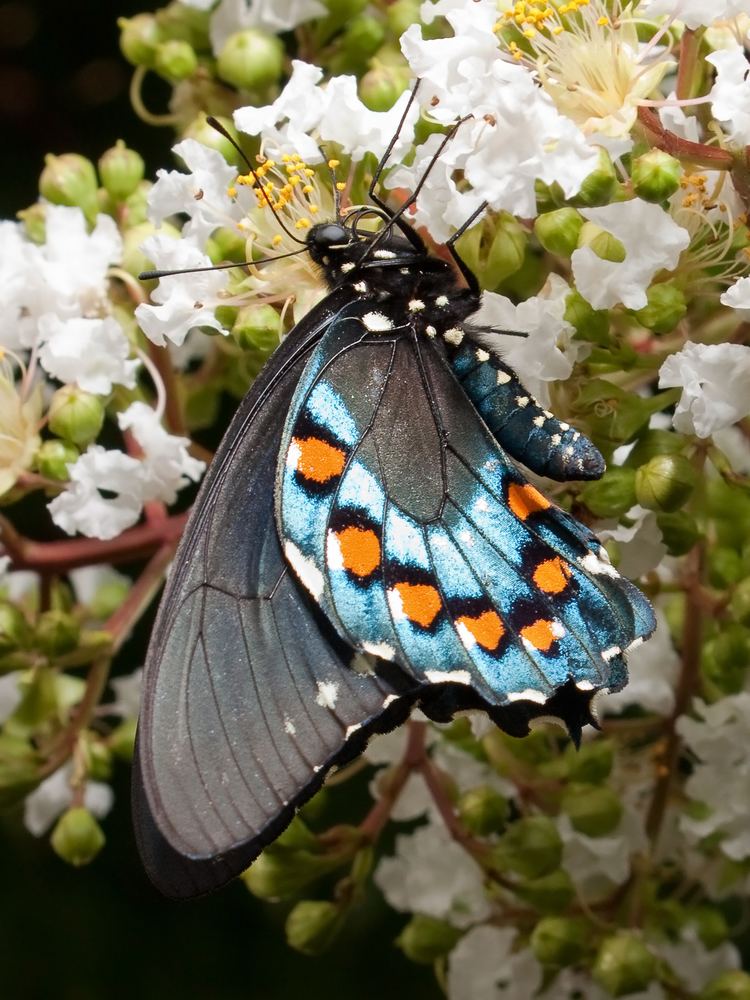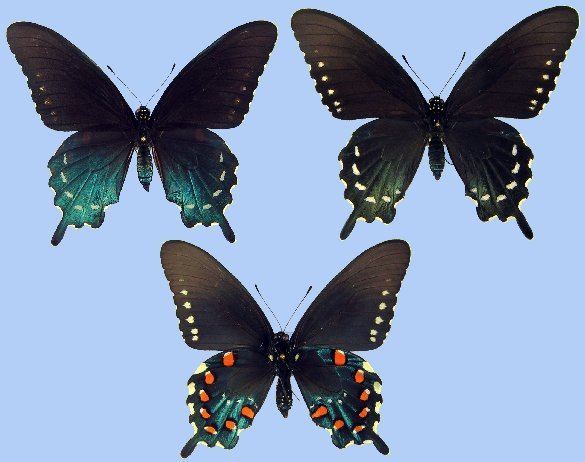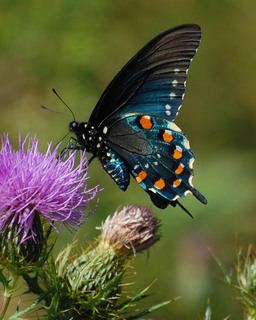Rank Species | Family Papilionidae | |
 | ||
Similar Butterfly, Battus, Swallowtail butterfly, Aristolochia, Black swallowtail | ||
Pipevine swallowtail battus philenor
Battus philenor, the pipevine swallowtail or blue swallowtail, is a swallowtail butterfly found in North America and Central America. The butterflies are black with iridescent-blue hindwings. They are found in many different habitats, but are most commonly found in forests. The black or red caterpillars feed on Aristolochia species, making them poisonous as both larvae and adults, while the adults feed on the nectar of a variety of flowers.
Contents
- Pipevine swallowtail battus philenor
- Battus philenor pipevine swallowtail pupa
- Description
- Subspecies
- Similar species
- Distribution and habitat
- Flight period
- Life cycle
- Host plants
- Nectar resources
- References

Battus philenor pipevine swallowtail pupa
Description

The upper surface of the hindwings are an iridescent blue or blue green with pale, arrowhead markings. Males have brighter metallic regions than females. The underside of the hindwing has seven orange submarginal spots surrounded by iridescent blue. Both surfaces of the forewings are black or dull blackish brown. Individuals of the Northern California subspecies, Battus philenor hirsuta, are smaller and hairier. Pipevine swallowtails can have a wingspan to up to 3 1⁄2 inches (89 mm). Battus philenor can usually be found in fields, meadows, gardens, parks, open woods, roadsides and stream sides. [1]
Subspecies
Listed alphabetically:
Similar species
The pipevine swallowtail is mimicked by many species, including the dark morph female eastern tiger swallowtail (Papilio glaucus), the spicebush swallowtail (P. troilus), the black swallowtail (P. polyxenes), the Ozark swallowtail (P. joanae), the sympatric subspecies red-spotted purple (Limenitis arthemis astyanax), and the female Diana fritillary (Speyeria diana).
Distribution and habitat

The butterfly ranges from across United States to Mexico, Islas Marías and onto Guatemala and Costa Rica. It rarely strays into southern Ontario. In the United States, the butterfly is found in New England down to Florida west to Nebraska, Texas, New Mexico, Arizona, California, and Oregon.
Flight period
The pipevine swallowtail is seen from April to October in the northern portion of its range and from February to November in the southern portion. There are two broods in the north and three or more in the south.
Life cycle
Males patrol for females in suitable habitats. Females will lay clusters of one to twenty reddish-brown eggs on the underside of host plant leaves. Young caterpillars are gregarious, while older larvae are solitary. The caterpillars will eat the leaves, stems, and seed capsules of the host plant. The larvae are either black or smoky red. Many fleshy filaments project from the sides of the body, the longest being on the anterior end. Over the dorsal part of the body are two rows of orange-red warts. The chrysalis is brown or green, with two horns on the head, a point on the thorax, and a ridge on each side of the abdomen. The abdomen is often patched with yellow. The chrysalis hibernates in areas with cold winters.
Host plants
Host plants for the caterpillars include the pipevine (Aristolochia species), including Dutchman's pipe (A. californica), Virginia snake root (A. serpentaria) and others. Pipevines confer a poisonous quality to the larvae and resulting adults, much as the monarch butterfly obtains protection by feeding on milkweed, or heliconiines by feeding on passion flowers.
Nectar resources
Adults seek nectar from flowers, including thistles (Cirsium species), bergamot, lilac, viper's bugloss, common azaleas, phlox, teasel, azaleas, dame's rocket, lantana, petunias, verbenas, lupines, yellow star thistle, buckeye, wild ginger and butterfly bush,
